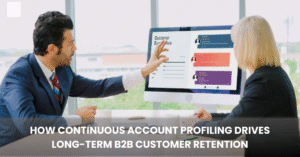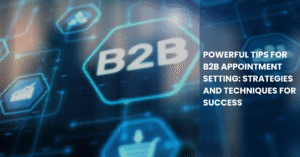A robust sales pipeline is the lifeblood of every business, whether big or small. However, a sales pipeline isn’t about the number of leads alone. It is also about lead quality. While companies understand this, many struggle with either thin pipelines or those clogged with vulnerable, low-quality prospects.
Now, that’s where targeted account profiling steps in. It refers to a powerful strategy that helps the sales team focus on sales qualified leads. However, how do you build such a solid pipeline that delivers value in the form of opportunities? If that’s your question as well, this blog answers it.
Common Challenges of Building a Strong Sales Pipeline
Honestly, creating a solid sales pipeline isn’t as straightforward. Even the most skilled or experienced sales team can struggle while building one. They may face numerous challenges, the most common ones of which can include;
- Poor Lead Quality: Marketing campaigns may generate volume but not prospects with a true purchase intent.
- Fragmented Data: Often, sales teams lack access to unified, accurate data. They have fragmented data that hinders their ability to identify priority accounts.
- Misaligned Sales and Marketing Teams: Disconnected sales and marketing teams often miscommunicate, wasting resources and losing opportunities.
- Restricted Personalization: Generic outreach communication lands in the prospect’s inbox but not their minds. It doesn’t yield any outcomes.
These challenges usually cause the pipeline to run dry. Therefore, targeted account profiling is imperative. Let’s explore more.
Why Does Targeted Account Profiling Matter?
Targeted account profiling involves understanding and categorizing prospects based on various factors such as technographics, firmographics, intent indicators, and buying behavior. So, instead of each lead that comes your way, you target accounts that match your ideal customer profile (ICP). Some reasons targeted profiling matters include:
- More relevant outreach that leads to higher conversion rates.
- More productive alignment between marketing and sales.
- Shorter sales cycles with better-qualified prospects.
- Better and more productive use of time and resources.
Partner with DemandFluence to turn targeted account profiling into consistent revenue growth
7 Steps to Build a Solid Pipeline with Targeted Account Profiling
Building a strong sales pipeline with targeted account profiling involves adhering to the step-by-step, organized process that generally includes the following.
1. Defining Your ICP
Analyze your best existing customers. Identify common traits like revenue, company size, industry, geography, pain points, and technology stack. It will help you define your ICP and form the guiding base for your team. Your team will then be able to focus on prospects that match your ICP – particularly those that matter to your business.
2. Validating Data
Rich and accurate data constitute the base for successful profiling. Therefore, you must ensure you have rich, validated data from different sources for comprehensive profiling. To ensure you have the data you need, you must partner with reliable third-party data providers and CRM enrichment tools. It will help you ensure your contact and account data is updated, relevant, and complete.
3. Segmenting Accounts and Prioritizing Them
Once you establish a clear ICP, you must segment potential accounts into tiers such as low, medium, and high fit. Obviously, you must target or prioritize high-fit accounts that signify a promising buying intent or those that match your strategic growth goals.
Accurate and detailed segmenting will help you focus on accounts that align with your revenue objectives. You will then be able to drive sales qualified leads that matter to your business’s growth.
4. Using Intent Data and Buying Signals
Intent data is crucial from the viewpoint of targeted account profiling. Thus, you must monitor intent data from search behavior, competitor interactions, or content engagement. The insights derived from this data will help you discover when prospects are active in the market. Your sales team can then reach out at the right time.
5. Aligning Sales and Marketing Efforts
Even the most targeted efforts can fail if the sales and marketing teams are misaligned. Therefore, you must ensure both of your teams collaborate productively on targeting strategies, outreach sequences, and messaging.
6. Personalizing Outreach Per Profile Insights
Generic messages reach the inbox and then the trash. Therefore, one of the keys to nurturing your prospects is to personalize your outreach based on a profile’s insights. Thus, you must use profile information that comprises pain points, technographic data, etc., to create personalized communication and outreach.
7. Measuring and Refining
Building a sales pipeline isn’t a set-and-forget thing. It demands constant monitoring and continuous refinements to keep it flowing. Accordingly, you must track engagement, conversions, and pipeline velocity metrics. Furthermore, you should ensure you review your profiling criteria to align with market changes or shifting client priorities.
Want to Build a Solid Sales Pipeline for Your Business?
Then partner with Demand Fluence. We help businesses build meaningful sales pipelines that keep your business perpetually full with sales qualified leads. Our experts understand your business’s requirements and strategic objectives to provide end-to-end support from defining your ICP to ensuring continuous improvements. Want to know more about our assistance? Please email us at hi@demandfluence.com.



























